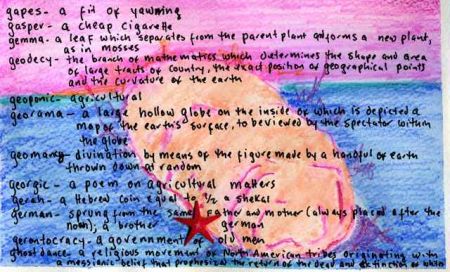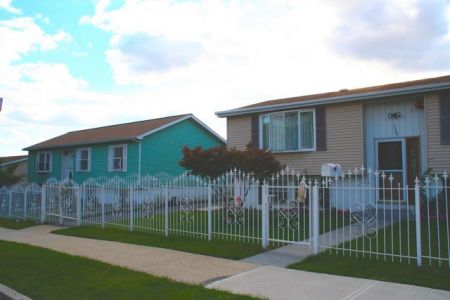Here is a list of words beginning with G from a forty year old dictionary I pored over during a residency at the MacDowell Colony. It was fascinating and disconcerting to discover how many amazing words have now disappeared not only from our usage but also from this etymological archive. Gone. We chose georgic — which sent me to a community garden in Brooklyn to reflect on agriculture in the city.
Places
Vaticinate: Charlotte Street, the Bronx
In 1976, Charlotte Street epitomized the decay and destruction of the South Bronx. President Jimmy Carter witnessed cement rubble on the devastated street and pronounced the need for grand changes that would transform the lives of poor people in the neighborhood and beyond. Rather than living in large, public housing, families needed homes of their own. Carter, along with other earnest city planners, were trying to vaticinate somehow, to imagine city life that would take on the pleasures that would come with a sense of ownership in a single family home.
More than thirty years later, Susan Agliata and I seek out this architectural anomaly in the heart of the Bronx. Charlotte Street is a street of modest but well-cared-for single and double story homes. Each home is surrounded by a six foot high fence and every window is barred. Unlike the rest of the borough which is bustling and croweded on a lovely fall afternoon, Charlotte feels simultaneously inhabited and desolate.
Welkin: The Sky Opens Up on a Brooklyn Street
As I turn the corner from Smith Street onto my short block in Brooklyn on a late winter afternoon just a few months after moving to the neighborhood, I notice that the sky somehow seems very different here. To my left and right the buildings take a few steps backwards, like cancan dancers on a stage, kicking their legs with lifted arms. After discovering the almost obsolete welkin, I know there is a single word I can use to describe this celestial beckoning.
Pelagic in a Junot Diaz short story
Pelagic took on new, transcendent meaning for me today when I read “Alma” a short story by Junot Diaz. The narrator of the story is in love with a girl but can’t resist the seductions of her best friend. When his girlfriend confirms her suspicions by peaking into his journal and then quietly confronts him, his “heart plunges, … and he is overwhelmed by a pelagic sadness.”
Pelagic: FreshKills, Staten Island
On Staten Island in search of pelagic experiences, Susan and I drive along Arthur Kill Road, a meandering marineside motor access leading to the Outerbridge Crossing to New Jersey. We had heard aboout a mysterious ship graveyard in the area and were intent to find it. We ask three bewildered Staten Island natives – on the street, in a diner, at a marina – where we might find this seemingly fascinating urban archeological wonder. Eventually, we find the rusty, decomposing, dinosaurs in the water next to a very active scrap metal depository, across the street from a hot pink tourist motel. These enormous, industrial carcasses jut forcefully up from the serene, yet polluted waterway of the Arthur Kill. We both stand in awe with our cameras poised and are immediately thrown off the grounds of the scrap metal yard. We are threatened with arrest and finally agree to leave the premises. Just a normal day in the production of Abecedarium NYC.
PELAGIC: City Island, Bronx
 There is a French word I dearly relish for its ability to express the sensation one has when feeling outside your home, your country, yourself. The word is “depayser” and literally speaking it translates as “to be outside one’s country”, experiencing a new state of mind and body, which has certainly been a part of my year of discovery here in New York City. I am constantly reminded of my often parochial attitude toward unfamiliar territory when I allow myself to discover a new place or community here in my own town.
There is a French word I dearly relish for its ability to express the sensation one has when feeling outside your home, your country, yourself. The word is “depayser” and literally speaking it translates as “to be outside one’s country”, experiencing a new state of mind and body, which has certainly been a part of my year of discovery here in New York City. I am constantly reminded of my often parochial attitude toward unfamiliar territory when I allow myself to discover a new place or community here in my own town.
So once again, I am in a position of awe, this time as I stand surrounded by a giddy flock of seagulls on the City Island Waterfront at the north –eastern most tip of the Bronx. The air is, sadly enough, unseasonably warm (an expression I have come to fear). Bronx native and Abecedarium media artist George Kuchar encouraged Susan and I to drive to this far most finger of the metropolitan area in pursuit of the quintessential pelagic experience. I stare long and hard at the horizon, at the waters of the Pelham Bay, the Long Island Sound and the Eastchester Bay, utterly transported by a sensation of openness. I am here and there all at once. One of my favorite scenes in Betty Smith’s A Tree Grows in Brooklyn occurs when Francie, the 11 year old heroine, is taken by her father to the shore to ride in a small fishing boat, smell the salt, gaze at the gulls. For the first time in her life, she has a pelagic sensation of the sea.
Nosogeography: Newtown Creek, Greenpoint, Brooklyn
Nosogeography is not a happy word. I’ve been trying to avoid shooting video for this word for weeks, not knowing when I would be able to face the daunting reality of filming a neighborhood where disease or the rumor of disease floats invisibly and silently through the air and the water. I have decided to focus on the largest environmental disaster in the history of New York City, the accidental spilling of 22 million gallons to oil in the Newton Creeek, a small waterway which serves as the dividing line between Brooklyn and Queens. By chance, I meet another experimental filmmaker, Scott Nyerges, who lives in Greenpoint, the closest residential neighborhood to the site of the spill. We agree to take a field trip to photograph . As we stand along the smelly, filth banks of the Newtown Creek, Scott recounts the daunting environmental disaster that occurred here in 1950 and is just beginning to be cleaned up.
Open City: Fort Schuyler, The Bronx
My understanding of open city is that it is a military designation that creates a hallow of protection over an urban setting. All of its defenses have been abandoned, and a kind of diplomatic trust ensues. Having lived through the initial shock and the harrowing aftereffects of September 11, 2001, I was wondering how it would feel to visit a perfectly preserved Civil War fort situated at the mouth of the East River to “protect and defend” the people of New York City. Fort Schuyler is a remarkably picturesque and serene enclave that is perched on the tip of a finger of land that juts into the water. Surrounded by the White Stone and the Throgs Neck Bridges, the fort would seem to have a more prominent place in the city’s consciousness. Instead, we felt as if our drive across this narrow piece of land was taking us to a remote island way off the coast and into the Atlantic Ocean.
Diglot: Albanian Burek, Arthur Avenue, the Bronx
Arthur Avenue seems to be best known for its Italian epicurean delights, so I am surprised to discover a multitude of Eastern European shops and restaurants on this famous Bronx neighborhood avenue. Since I lived in Sarajevo, Bosnia for several weeks in 2001, I am particularly pleased and intrigued by the presence of this large, unexpected community. Susan and I spent a day visiting a Montenegrin sundry, a Kosovo bar and grill, an Albanian video store and finally the most welcoming, aromatic pizza parlor I have ever walked into in my life. I would imagine there must be at least ten Tony’s Pizza Parlors in New York City, but the Arthur Avenue Tony’s has a quality all its own. Fylip, the owner and kitchen wunderkind behind this Albanian community gathering spot, welcomes each and every customer inside this corner restaurant at the end of the avenue. Of course, we immediately smelled the spectacular scent of Burek meat, cheese and spinach pastries. Within seconds, however, our curiosity was piqued even further upon noticing the framed photos of Mother Theresa, the large statue bust of a notorious Albanian military leader, and the sounds of many Albanian women and men chattering in their native language. We were the strangers, the bewildered outsiders, and we knew right away that this would be the perfect place to create another mini-DIGLOT documentary. A few weeks after our initial visit, Susan and I returned to Tony’s Pizza to listen to the owner, his father and the two extraordinary cooks, all fairly recent Albanian emigrants, talk in English and their native language.

